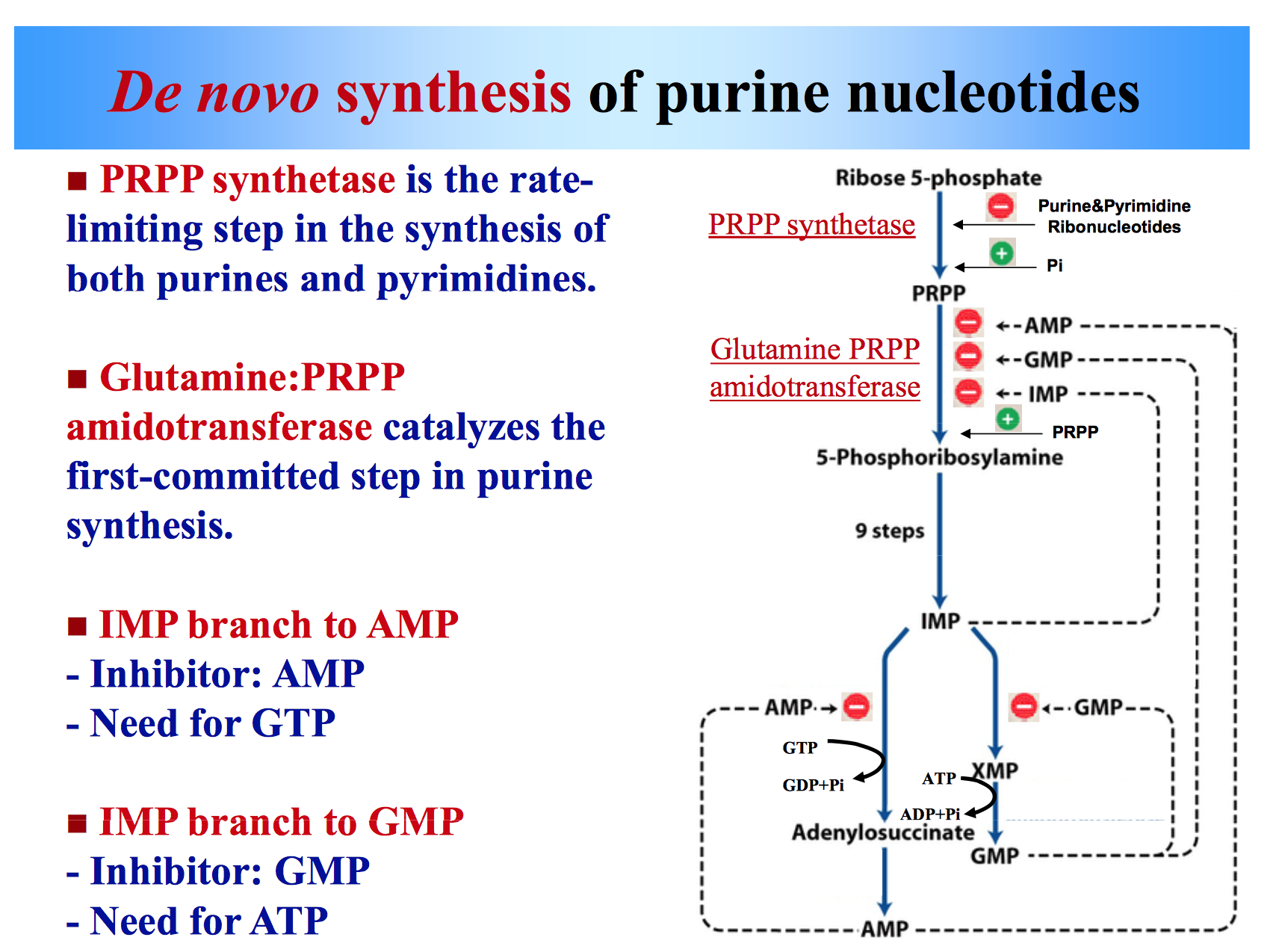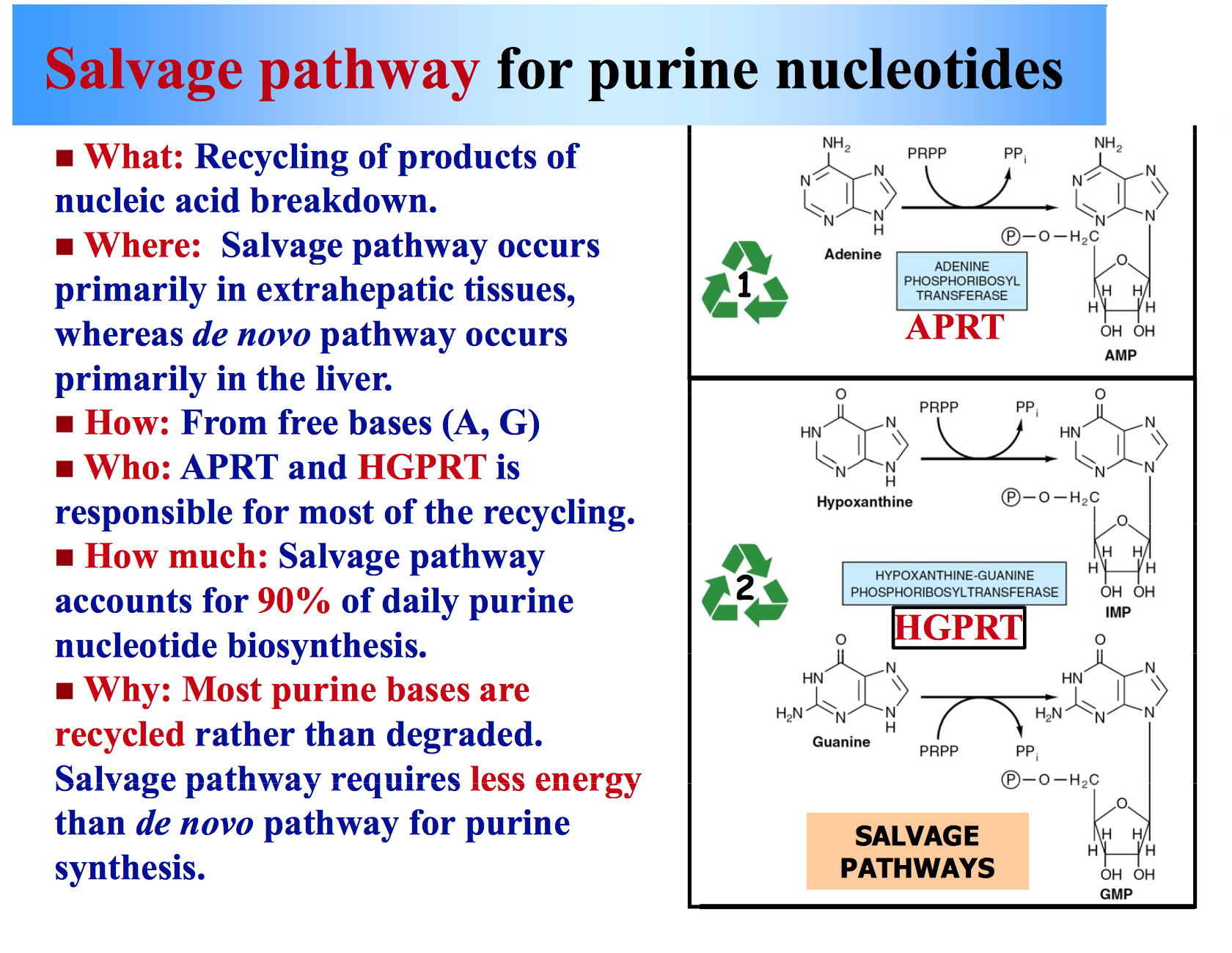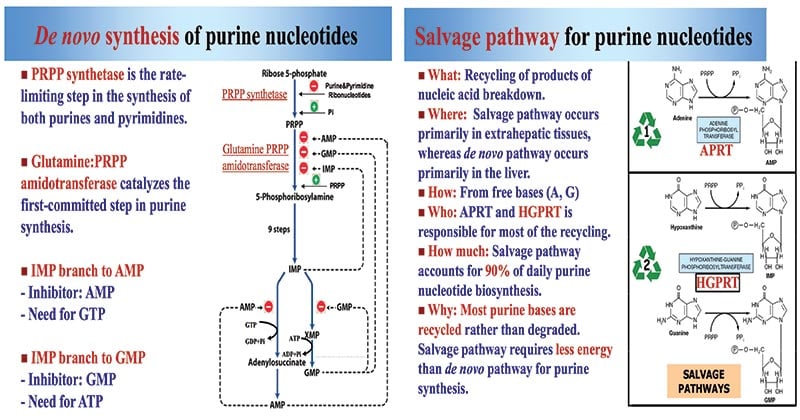There are two pathways of synthesis of purine nucleotides:
- De Novo synthesis pathway, and
- Salvage pathway.
Interesting Science Videos
The De novo synthesis of Purine
The de novo synthesis of purine nucleotide means using phosphoribose , amino acids , one carbon units and CO2 as raw materials to synthesize purine nucleotide from the beginning. It is the main synthesis pathway of nucleotides.

Location
Purine synthesis occurs in all tissues. The major site of purine synthesis is in the liver and, to a limited extent, in the brain.
- Substrates: Ribose-5-phosphate; glycine; glutamine; H2O; ATP; CO2; aspartate.
- Products: GMP; AMP; glutamate; fumarate; H2O.
Overview of the pathway
- Ribose-5-phosphate (as provided by the pentose-phosphate pathway) is converted into PRPP (Phosphoribosyl pyrophosphate) by PRPP synthetase, in a step requiring one ATP.
- In the committed step in the process, an α-amino group is then added to PRPP from glutamine to form 5-phosphoribosylamine. This reaction is catalyzed by glutamine PRPP amidinotransferase.
- A series of nine reactions results in the formation of IMP (Inosine 5′-monophosphate).
- IMP can then be transformed either to GMP by IMP dehydrogenase , or to AMP by adenylosuccinate synthetase .
Reactions of the pathway
(1) The purine base is synthesized on the ribose moiety.
(a) 5′-Phosphoribosyl 1′-pyrophosphate (PRPP), which provides the ribose moiety, reacts with glutamine to form phosphoribosylamine. This first step in purine biosynthesis produces N9 of the purine ring and is inhibited by AMP and GMP.
(b) The entire glycine molecule is added to the growing purine precursor. Then C8 is added by formyl-FH4, N3 by glutamine, C6 by CO2, N1 by aspartate, and C2 by formyl-FH4.
(c) IMP, which contains the base hypoxanthine, is generated. IMP is cleaved in the liver. Its free base, or nucleoside, travels to various tissues where it is reconverted to the nucleotide.
(2) IMP is the precursor of both AMP and GMP.
(a) Each product, by feedback inhibition, regulates its own synthesis from the IMP branch point as well as inhibits the initial step in the pathway.
(b) AMP and GMP can be phosphorylated to the triphosphate level.
(c) The nucleotide triphosphates (ATP and GTP) can be used for energy-requiring processes or for RNA synthesis.
(3) The reduction of the ribose moiety to deoxyribose occurs at the diphosphate level and is catalyzed by ribonucleotide reductase, which requires the protein thioredoxin.
(a) After the diphosphates are phosphorylated, dATP and dGTP can be used for DNA synthesis.
(4) Purine bases can be salvaged and converted between free bases, nucleotides, and nucleosides by a series of reactions.
Important enzymes and Regulation
- PRPP synthetase: Inhibited by AMP, IMP, and GMP.
- Glutamine PRPP amidinotransferase: Inhibited by AMP, IMP, and GMP.
- IMP dehydrogenase: Inhibited by GMP.
- Adenylosuccinate synthetase: Inhibited by AMP.
Pharmacologic Inhibitors
Although not shown, tetrahydrofolate is involved in two reactions of de novo purine synthesis. Folic acid analogs, such as methotrexate, inhibit the formation of tetrahydrofolate and thus interfere with purine synthesis.
Purine Salvage Pathway
A salvage pathway is a pathway in which nucleotides are synthesized from intermediates in the degradative pathway for nucleotides.

Location
Purine synthesis via the salvage pathways occurs in all tissues. It is especially important in the brain and the bone marrow.
- Substrates: Hypoxanthine; PRPP; guanine; adenine.
- Products: GMP; AMP; IMP.
Overview of the Pathway
- Bases from degraded nucleic acids can be converted back into purine nucleotides via the salvage pathways.
- Hypoxanthine can be combined with PRPP (which acts as the donor of ribose-5 phosphate) to form IMP in a reaction catalyzed by Hypoxanthine-guanine phosphoribosyltransferase (HGPRT).
- IMP can subsequently be transformed into AMP or GMP via the last few steps of the pathway of de novo purine synthesis.
- HGPRT also catalyzes the reaction which combines PRPP with guanine to form GMP.
- Adenine phosphoribosyltransferase converts adenine and PRPP to form AMP.
Important enzymes and Regulation
- HGPRT: Inhibited by IMP and GMP.
- Adenine phosphoribosyltransferase: Inhibited by AMP.
Associated Disease
Deficiency of HGPRT leads to Lesch-Nyhan syndrome, which is characterized by self-mutilation and CNS deterioration.
Significance of Purine Synthesis
- Purines serve as building blocks of nucleic acids.
- ATP plays an important role in energy transformation.
- ATP, ADP, and AMP may function as allosteric regulators and participate in regulation of many metabolic path-ways.
- ATP involves in covalent modification of enzymes. ways.
- cGMP are secondary messengers.
- Salvage pathways are used to recover bases and nucleosides that are formed during degradation of RNA and DNA.
- In comparison to de novo pathway, salvage pathway is energy-saving.
- In brain and bone marrow tissues salvage pathway is the only pathway of nucleotide synthesis.

References
- Smith, C. M., Marks, A. D., Lieberman, M. A., Marks, D. B., & Marks, D. B. (2005). Marks’ basic medical biochemistry: A clinical approach. Philadelphia: Lippincott Williams & Wilkins.
- https://www.slideshare.net/hirapure/de-novo-and-salvage-pathway-of-purines
- Rodwell, V. W., Botham, K. M., Kennelly, P. J., Weil, P. A., & Bender, D. A. (2015). Harper’s illustrated biochemistry (30th ed.). New York, N.Y.: McGraw-Hill Education LLC.
- John W. Pelley, Edward F. Goljan (2011). Biochemistry. Third edition. Philadelphia: USA.

Very helpful
THANKS